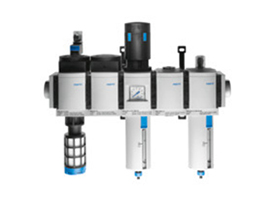FESTO (Festo) Air Source Processing Unit MS9-LR-AGH-D8-RG-BAR Overview
FESTO (Festo), as a renowned company in the field of automation technology, is known for the high quality and reliability of its products. The Air Source Processing Unit MS9-LR-AGH-D8-RG-BAR is one of many outstanding products from Festo, playing a crucial role in industrial automation systems.
This air source processing unit is mainly used for the treatment of compressed air, ensuring that the air entering the pneumatic system is clean, dry, and has stable pressure. It integrates various functions that effectively filter impurities, moisture, and oil mist from the air, providing high-quality air to pneumatic equipment, thereby extending the service life of the equipment, and improving the operational efficiency and stability of the system.
MS9-LR-AGH-D8-RG-BAR adopts advanced design concepts and manufacturing processes, featuring a compact structure and modular design. This design makes installation and maintenance very convenient, allowing users to flexibly combine different modules according to actual needs to meet various application scenarios.
Features and Advantages of FESTO (Festo) Air Source Processing Unit MS9-LR-AGH-D8-RG-BAR
Firstly, in terms of filtration performance, this air source processing unit is equipped with efficient filters. It can precisely filter out solid particles, dust, and liquid water from the air, with a filtration precision reaching the micron level. This is particularly important for pneumatic equipment that requires high air quality, such as precision pneumatic valves and cylinders, effectively preventing equipment failures and wear caused by impurities entering.
Secondly, MS9-LR-AGH-D8-RG-BAR has excellent pressure regulation capabilities. It can accurately adjust the output pressure according to actual needs, ensuring that the pneumatic system operates under stable pressure conditions. The pressure regulation range is wide, and the adjustment process is smooth and precise, meeting the pressure requirements under different working conditions.
Furthermore, this air source processing unit also has good drainage functions. It adopts advanced drainage technology, automatically draining the water collected by the filter without manual intervention. This not only improves work efficiency but also reduces the risk of corrosion and damage caused by the accumulation of moisture.
In addition, Festo's air source processing unit has high reliability and durability. Its housing is made of high-strength materials, capable of withstanding certain impacts and vibrations, adapting to various harsh industrial environments. At the same time, the internal key components are carefully designed and optimized, with long life and stable performance.
Application Scenarios of FESTO (Festo) Air Source Processing Unit MS9-LR-AGH-D8-RG-BAR
In the automotive manufacturing industry, pneumatic systems are widely used in the assembly production lines of automobiles. MS9-LR-AGH-D8-RG-BAR can provide clean and stable air sources for these pneumatic equipment, ensuring the
Air Source Processing Unit MS9-LR-AGH-D8-RG-BAR belongs to the Compressed Air Treatment series under FESTO company, model number MS9-LR-AGH-D8-RG-BAR. To purchase or inquire about Air Source Processing Unit MS9-LR-AGH-D8-RG-BAR, you can directly contact 158 0047 0089 (Mr. He).



